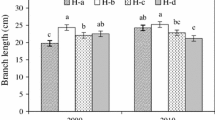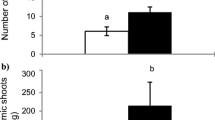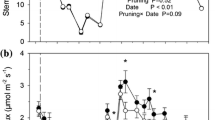Abstract
The photosynthetic response to pruning was measured in two Eucalyptus regnans stands, aged 2 and 3 years, located in areas of high productivity on the coast of the province of Arauco, Chile. Variables such as rates of CO2 assimilation and stomatal conductance were measured in three ages of foliage on trees with different pruning severity treatments, which corresponded to the removal of 0 % (control), 30, 50 and 70 % of live crown length. The 2-year-old stand measurements were performed at the time of pruning and 6, 10, 14 and 18 weeks later, and the 3-year stand, 5, 9, 18 and 28 weeks after pruning. In both trials, significant differences were found between the foliage ages for all instances of measurement showing the mature foliage the highest values up to 30 % higher than old foliage. There were also significant differences between pruning severity treatments in both trials in which, in general, the highest values of CO2 assimilation were observed among the highest pruning severity treatments with values up to 40 % higher than the unpruned trees.







Similar content being viewed by others
References
Alcorn PJ, Bauhus J, Thomas DS, James RN, Smith RGB, Nicotra AB (2008) Photosynthetic response to green crown pruning in young plantation-grown Eucalyptus pilularis and E. cloeziana. For Ecol Manage 255:3827–3838
Barry KM, Pinkard EA (2012) Growth and photosynthetic responses following defoliation and bud removal in eucalypts. For Ecol Manage 293:9–16
CIREN, CORFO (1983) Ortofotos VIII Región, anexo regional. Santiago, Chile. 17 p
Donnelly R, Flynn R, Shield, ED (2003) The global Eucalyptus wood products industry: a progress report on achieving higher value utilization. Dana Publisher, New Zealand. 275p
England J, Attiwill P (2006) Changes in leaf morphology and anatomy with tree age and height in the broadleaved evergreen species, Eucalyptus regnans F. Muell. Trees 20(1):79–90
Feely RA, Sabine CL, Lee K, Berelson W, Kleypas J, Fabry VJ, Millero FJ (2004) Impact of anthropogenic CO2 on the CaCO3 system in the oceans. Science 305:362–366
Flynn B (2003) Eucalyptus: having an impact on the global solidwood industry. Wood Resources International Report. WRI (www.wri-ltd.com)
Forrester DI, Collopy JJ, Beadle CL, Warren CR, Baker TG (2012) Effect of thinning, pruning and nitrogen fertiliser application on transpiration, photosynthesis and water-use efficiency in a young Eucalyptus nitens plantation. For Ecol Manage 266:286–300
Littell RC, Henry PR, Ammerman CB (1998) Statistical analysis of repeated measures data using SAS procedures. J Anim Sci 76:1216–1231
Maurin V, DesRochers A (2013) Physiological and growth responses to pruning season and intensity of hybrid poplar. For Ecol Manage 304:399–406
Medhurst J, Pinkard E, Beadle C, Worledge D (2006) Photosynthetic capacity increases in Acacia melanoxylon following form pruning in a two-species plantation. For Ecol Manage 233:250–259
Medrano H, Escalona J, Bota J, Gulías J, Flexas J (2002) Regulation of photosynthesis of C3 plants in response to progressive drought: stomatal conductance as a reference parameter. Ann Bot 89:895–905
Montagu K, Kearney D, Smith R (2003) The biology and silviculture of pruning planted Eucalypts for clear wood production—a review. For Ecol Manage 179:1–13
Nowak RS, Caldwell MM (1984) A test of compensatory photosynthesis in the field: implications for herbivory tolerance. Oecologia 61:311–318
Pinkard EA (2003) Physiological and growth responses related to pattern and severity of green pruning in young Eucalyptus globulus. For Ecol Manage 182(1):231–245
Pinkard EA, Beadle CL (1998a) Effects of green pruning on growth and stem shape of Eucalyptus nitens (Deane and Maiden) Maiden. New For 15:107–126
Pinkard EA, Beadle CL (1998b) Regulation of photosynthesis in Eucalyptus nitens (Deane and Maiden) Maiden following green pruning. Trees 12:366–376
Pinkard EA, Beadle CL (2000) A physiological approach to pruning. Int For Rev 2(4):295–304
Pinkard E, Beadle C, Davidson N, Battaglia M (1998) Photosynthetic responses of Eucalyptus nitens (Deane and Maiden) Maiden to green pruning. Trees-Struct Function 12:119–129
Quentin AG, O’Grady AP, Beadle CL, Worledge D, Pinkard EA (2011) Responses of transpiration and canopy conductance to partial defoliation of Eucalyptus globules trees. Agric For Meteorol 151(3):356–364
Reich PB, Walters MB, Krause SC (1993) Growth, nutrition and gas exchange of Pinus resinosa following artificial defoliation. Trees 7:67–77
Sands P (1995) Modelling canopy production. II. From single-leaf photosynthesis parameters to daily canopy photosynthesis. Funct Plant Biol 22:603–614
SAS Institute Inc (1990) SAS/STAT user’s guide, version 6. SAS Institute Inc., Cary
Sedjo RA (1999) The potential of high-yield plantation forestry for meeting timber needs. New For 17:339–359
Turnbull TL, Adams MA, Warren CR (2007) Increased photosynthesis following partial defoliation of field-grown Eucalyptus globulus seedlings is not caused by increased leaf nitrogen. Tree Physiol 27:1481–1492
von Caemmerer S, Farquhar GD (1984) Effects of partial defoliation, changes of irradiance during growth, short-term water stress and growth at enhanced p(CO2) on the photosynthetic capacity of leaves of Phaseolus vulgaris L. Planta 160:320–329
Wardlaw T, Mohammed CL, Barry KM, Eyles A, Wiseman D, Beadle CL, Battaglia M, Pinkard EA, Kube P (2003) Interdisciplinary approach to the study and management of stem defect in eucalypts. NZ J For Sci 33(3):385–398
Acknowledgments
The authors wish to acknowledge the valuable help of “Forestry Tasmania” for the loan of equipment CIRAS, which allowed to make the measurements for this study. Also wish to acknowledge the contribution of the company “Regnans Ltda.” to allow the installation of the trials on their properties.
Author information
Authors and Affiliations
Corresponding author
Rights and permissions
About this article
Cite this article
Lisboa, M., Acuña, E., Cancino, J. et al. Physiological response to pruning severity in Eucalyptus regnans plantations. New Forests 45, 753–764 (2014). https://doi.org/10.1007/s11056-014-9434-8
Received:
Accepted:
Published:
Issue Date:
DOI: https://doi.org/10.1007/s11056-014-9434-8




